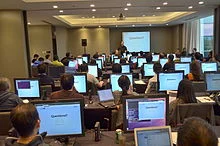America's training deficit
A computer-skills training class.
From Robert Whitcomb's "Digital Diary,'' in GoLocal24.com
It appears that the recent lethal ship collisions involving the Navy may be attributable in part to excessive work hours, rushed training and an over-emphasis on cheaper, online training, as opposed to teaching in person. The U.S. military has been overstretched for a long time: The collisions may be yet another example.
This reminds me of an intensifying problem in much of American business over the past few decades – major cutbacks intraining. The reason is simple: Doing a thorough job of training your people, while it helps build the long-term strength of an enterprise, cuts into quarterly profits.
I saw this inthe newspaper business. When most newspaper companies were closely held, and often family-controlled, in the ‘70s and ‘80s, many of these enterprises spent a great deal of time and money training their people, especially in new computer and other production-related systems. But then it became clear that many of the larger newspaper companies would eventually go public, whereupon many were then quickly sold to other public companies.
As this happened, there was less and less training because that would have cut into quarterly earnings and thus the stock price – a key metric for senior execs as well as shareholders (the most important of which were usually pension funds and other institutions).
I saw this happen at the old Providence Journal Co. Costs were slashed to dress up the company for sale.
But in, for example, such very successful economies as Germany’s andthe Scandinavian nations’, managements take amuch longer view and expend much more money and time in training on a per-capita basis than found in short-term-focused America.
